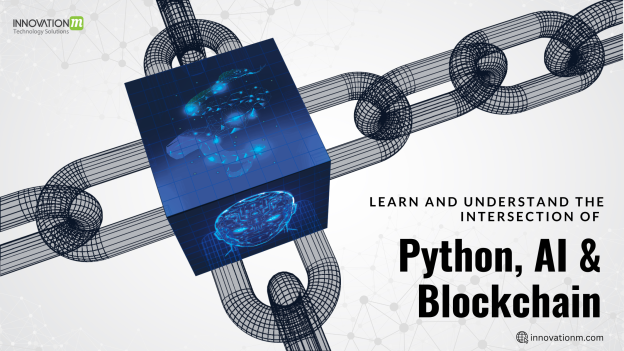In recent years, three technologies have dominated the tech landscape: Python, Artificial Intelligence (AI), and Blockchain. Individually, they have revolutionized industries, but when combined, they unlock unprecedented possibilities. This blog explores the intersection of Python, AI, and Blockchain, highlighting how they complement each other and the opportunities they create for developers and businesses.
Why Python, AI, and Blockchain?
Python: The Universal Programming Language
Python has become the go-to language for developers due to its simplicity, readability, and versatility. Its extensive libraries and frameworks make it ideal for AI, data science, web development, and now, Blockchain development. Python’s ease of use and strong community support make it a natural choice for integrating AI and Blockchain.
AI: The Brain Behind Automation
AI empowers machines to learn, reason, and make decisions. From natural language processing (NLP) to computer vision, AI is transforming industries like healthcare, finance, and e-commerce. Python’s libraries, such as TensorFlow, PyTorch, and Scikit-Learn, have made AI accessible to developers worldwide.
Blockchain: The Backbone of Decentralization
Blockchain is a decentralized ledger technology that ensures transparency, security, and immutability. It powers cryptocurrencies like Bitcoin and Ethereum and is now being used in supply chain management, voting systems, and more. Python’s simplicity and libraries like web3.py and PyCryptodome make it a popular choice for Blockchain development.
The Intersection of Python, AI, and Blockchain
The convergence of these technologies is creating innovative solutions across
industries. Here’s how they work together:
1. AI-Powered Smart Contracts
Smart contracts are self-executing contracts with the terms of the agreement directly written into code. By integrating AI, smart contracts can become more dynamic and intelligent. For example:
Predictive Smart Contracts: AI can analyze data to trigger contracts based on predictions (e.g., insurance payouts based on weather forecasts).
Self-Optimizing Contracts: AI can optimize contract terms in real-time based on changing conditions.
Python libraries like web3.py allow developers to interact with Blockchain networks, while AI models can be integrated using frameworks like TensorFlow.
2. Decentralized AI Models
Centralized AI models often face issues like data privacy, security, and bias. Blockchain can decentralize AI, ensuring transparency and fairness. For example:
Federated Learning: AI models can be trained on decentralized data without compromising privacy. Blockchain ensures data integrity and tracks contributions.
AI Marketplaces: Developers can share and monetize AI models on Blockchain platforms, with Python serving as the bridge for integration.
3. Secure Data Sharing for AI Training
AI models require vast amounts of data, but data privacy is a major concern. Blockchain enables secure, transparent, and auditable data sharing. For example:
Data Marketplaces: Blockchain can create decentralized platforms where
users can sell or share data for AI training.
Data Provenance: Blockchain ensures the authenticity and traceability of data
used in AI models.
Python’s data processing libraries, like Pandas and NumPy, combined with
Blockchain tools, make this integration seamless.
4. AI for Blockchain Optimization
AI can enhance Blockchain performance by addressing scalability and efficiency challenges. For example:
Consensus Algorithm Optimization: AI can improve consensus mechanisms like Proof of Work (PoW) or Proof of Stake (PoS) by predicting network behavior.
Fraud Detection: AI can analyze Blockchain transactions to detect fraudulent activities in real-time.
5. Tokenization of AI Assets
Blockchain enables the creation of digital tokens, which can represent ownership or access rights to AI models, datasets, or services. For example:
AI Model Tokens: Developers can tokenize AI models, allowing users to pay for access using cryptocurrencies.
Data Tokens: Data providers can tokenize datasets, ensuring fair compensation for their contributions.
Python’s web3.py library simplifies the process of creating and managing tokens on Blockchain networks.
Real-World Applications
The intersection of Python, AI, and Blockchain is already driving innovation in various industries:
1. Healthcare
Secure Patient Data Sharing: Blockchain ensures secure sharing of patient data, while AI analyzes the data for diagnostics and treatment recommendations.
Drug Discovery: AI models can accelerate drug discovery, with Blockchain ensuring transparency in research data.
2. Finance
Fraud Detection: AI analyzes transaction patterns, while Blockchain ensures the integrity of financial records.
Decentralized Finance (DeFi): AI-powered smart contracts automate lending, borrowing, and trading.
3. Supply Chain
Transparent Tracking: Blockchain tracks products across the supply chain, while AI optimizes logistics and predicts demand.
Counterfeit Detection: AI identifies counterfeit products, with Blockchain ensuring product authenticity.
4. Gaming
AI-Driven Gameplay: AI enhances gaming experiences, while Blockchain enables ownership of in-game assets through NFTs (Non-Fungible Tokens).
Getting Started: Tools and Libraries
To explore the intersection of Python, AI, and Blockchain, here are some tools and libraries you can use:
For AI:
TensorFlow and PyTorch: For building and training AI models.
Scikit-Learn: For traditional machine learning algorithms.
OpenAI GPT: For natural language processing tasks.
For Blockchain:
web3.py: A Python library for interacting with Ethereum and other Blockchain networks.
PyCryptodome: For cryptographic operations.
Hyperledger Fabric: A Blockchain framework for enterprise solutions.
For Integration:
Flask or FastAPI: For building APIs to connect AI models with Blockchain networks.
Pandas and NumPy: For data processing and analysis.
Challenges and Future Outlook
While the integration of Python, AI, and Blockchain holds immense potential, there are challenges to address:
Scalability: Blockchain networks need to handle large-scale AI computations.
Regulation: Legal frameworks for AI and Blockchain are still evolving.
Interoperability: Seamless integration between different Blockchain networks and AI systems is crucial.
Despite these challenges, the future looks promising. As these technologies mature, we can expect more innovative solutions that leverage their combined strengths.
Conclusion
The intersection of Python, AI, and Blockchain is a fascinating area of exploration for developers and businesses alike. Python’s versatility makes it the perfect tool to bridge the gap between AI and Blockchain, enabling innovative applications across industries. Whether you’re building intelligent smart contracts, decentralized AI models, or secure data marketplaces, the possibilities are endless. Start experimenting with these technologies today, and be part of the
revolution that is shaping the future of technology!
 End to End Technology Solutions
End to End Technology Solutions
